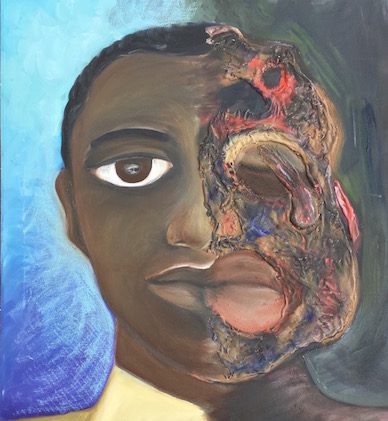Emmett Louis Till was born and raised in Chicago, Illinois, which is situated in the northern part of the United States where racism and discrimination were much less overbearing when compared to its southern counterparts. Desiring a vacation, Mamie Till, Emmett’s mother, sent her fourteen-year-old son down south to Tallahatchie County, Mississippi to stay with his uncle, Moses Wright. To his detriment, Emmett didn’t grasp how fundamentally different the South was as compared to the North, especially Mississippi, who led the nation in race-related murders in 1955. Emmett did not “hang his head” or add “the customary ‘sir’” when talking to white storekeepers. He was just completely naive to the ways and culture of the South. Unfortunately, this would come back to torture him sooner rather than later, as he wouldn’t even last a month in the South.1
On August 24, 1955, Till and several other teenagers drove down to Money, Mississippi and stopped at a grocery store owned and operated by Roy and Carolyn Bryant. Roy Bryant and his half-brother, J.W. Milam were away trucking shrimp to Texas, leaving Carolyn and Milam’s wife, Juanita at the store. After being egged on by the local black teenagers to ask Mrs. Bryant on a date, Emmett, falling victim to peer pressure, entered the grocery store. He bought a pack of gum, then foolishly, he grabbed her hand, flirted with her, and asked her out for a date. She yanked her hand away and ran to the back of the store in search of a gun. Realizing the imminent danger, one of Till’s cousins grabbed him and dragged him out of the store. As he was being dragged away, he wolf-whistled at Mrs. Bryant. Unfortunately, this wasn’t the last time Emmett saw a Bryant. This was only the beginning.2
In the early hours of August 28, upon learning about the incident, Roy Bryant and J.W. Milam went to the Wrights’ residence and abducted Emmett. They brutally tortured him, murdered him, and dumped his body into the Tallahatchie River.

Racism is prejudice, discrimination, or antagonism directed against someone of a different race based on the belief that one’s race is superior. This ideology/societal pressure was overwhelming on the African-Americans of the United States South. This part of the U.S. had attempted to secede from the country in order to protect its culture and its oppressive nature over its African-American population. The oppressive pressures of the Southern culture for centuries subdued Black southerners, instilling fear in their hearts and minds. For instance, in Mississippi, the Ku Klux Klan was newly revived and African Americans were impoverished. The barriers separating Black and White southerners were strictly enforced by the threat of social violence from groups such as the KKK. In the 1950s, Black Mississippians experienced the fruit of Jim Crow laws, as everything was segregated from bathrooms to jails to schools to water fountains to public transportation.3
And the oppression ran deep in the veins of Mississippi as Mississippi led the nation in race-related murders in 1955. Mississippi was a place where exercising your right to vote as an American could get you killed in cold blood if you were a Black southerner. For George Lee and Lamar Smith, this was reality for the two activists who both tried to vote. Both men’s activism in working to get other African-Americans registered to vote had gotten them killed. In Lamar Smith’s case, he was shot dead on the courthouse lawn while urging African Americans to vote in a local run-off election. No one was prosecuted. The assailant ran free. These political assassinations received little press coverage. These cases showed black southerners that if they even tried to vote, they would be killed, and their deaths would be in vain, as there wouldn’t be an outcry in the news, as the southern, white-owned newspapers didn’t care. Additionally, there would be no repercussions for the murderers as the police wouldn’t care to investigate. When a black person was stolen from or lynched, local law enforcement did “little to investigate and bring a culprit to justice.” On the contrary, if the prime suspect or suspects of a criminal investigation were black, their guilt or innocence “mattered little.” A black southerner was “guilty until proven innocent,” and evidence was often planted to gain a conviction. On top of all that, going through the court system, a black southerner would be judged by a “jury of one’s peers” as promised by the U.S. Constitution, which almost always produced an all-white, all-male jury who “wanted nothing more than to see a black person behind bars.”4 So, black southerners not only would be killed in cold blood and forgotten, but they would also be framed, convicted of a crime they did not commit, and left to rot in prison. “If you see a white woman coming down the street, you get off the sidewalk and drop your head. Don’t even look at her,” Mamie Till, a native of the South herself, warned her son before he left to Mississippi. This attests to the fear the southern culture instilled in the southern blacks as they wouldn’t dare provoke a white southerner, fearing the extreme ramifications.5
However, the Emmett Till case wouldn’t be forgotten. On the contrary, it would cause a great outcry. On the morning of that same day of August 28, the Wrights reported the abduction to the local police while one of the visitors in their home phoned Mamie Till. By noon, Milam and Bryant were arrested. They confessed to kidnapping the boy, but claimed they had released him after realizing he was the wrong person. They remained in jail on the suspicion of murder. Three days later, Till’s body was found by a fisherman in the Tallahatchie River. Till’s body was found brutally disfigured with a gin fan wired to his neck. Upon its discovery, Mamie Till demanded the body be sent home to Chicago. Here, she held an open casket funeral and let the world gaze upon not only the horror Till had experience but the reality of the oppressive nature of the Southern culture. Mrs. Till let newspapers take on the story.6
On Sept. 15, 1955, Jet, a nationwide, black-owned publication, ran photos of Emmett Till’s disfigured corpse galvanizing the nation as they were appalled by the severity of Till’s disfigurement. They cried. They shouted. They begged for justice. But, there was something else brewing in Mississippi.7

Compared to the black southerners’ experience, white southerners, the oppressors, had been benefiting from the constraints their culture placed on the African-American people as they lived in an environment structured to where African-Americans couldn’t even compete with them, not due to lack of ability, but due to the absence of opportunity and resources. In 1952, 10.2% of black Americans were illiterate, while conversely, only 1.8% of white Americans were illiterate.8 To this point, the social structure of the South has been based on “White Supremacy.” This ideology was protected and cultivated for so long through various avenues, such as slavery, where African-Americans were forced to work and be subject to abuse, or the Dred-Scott court case that labeled African-Americans property, or the Three-Fifths Compromise that declared African-Americans worth three-fifths of a person, or the many Jim Crow laws that effectively segregated the two races. For over 200 years, White Supremacy, the ideology that White Americans were superior to African-Americans, was permitted to cultivate and, as a result, deeply rooted itself into the culture and way of life of the South. The South’s way of life, time and time again, oppressed African-Americans as they were, first subject to abuse through the avenue of slavery, then later through the avenue of Jim Crow laws. White southerners experienced higher quality school books, higher-quality teachers, better seats on the bus, and the greatest power of all, immunity. They were immune to an entire race of people. They were completely unaffected by the actions of an entire race. Whatever they wanted, they got top priority over an entire race of people no matter the difference in skills and work ethic. They could terrorize African-Americans and demand submission, which is a testament to the power white southerners exercised over black southerners. Mamie Till, herself, warned her son to be mindful of this and simply do as they must. An underlying effect of the heavy discrimination in the South was its unifying effect on white southerns as they became closer, as they could all play under the umbrella of White Supremacy. Whether you were from Georgia, Mississippi or Alabama, as long as they were both white, they could acknowledge the other wasn’t black, therefore, they couldn’t be that bad.9

On September 19, 1955, Roy Bryant and J.W. Milam stood trial to a white male judge and a jury of all white southern men. Mamie Till took the stand stating that the disfigured body found was, in fact, her son’s. Next, Moses Wright took the stand. Mr. Wright had been in hiding ever since the incident and came out now to give eyewitness testimony. As the “white eyes” gazed upon him, Mr. Wright gave damning evidence as he rose up and pointed at Bryant and Milam, identifying the two as ones who abducted Emmett. Finally, a young sharecropper, Willie Reed, was persuaded to testify, despite his fear for his life. Mr. Reed told the courtroom about the shrieks and screams he heard from the barnyard where Bryant and Milam tortured Emmett. Fearing for their lives after giving incriminating eyewitness accounts, both, Mr. Wright and Mr. Reed were sent to Chicago to flee the threat of being killed by angry white southerners, the former vowing “never to return.”10
Despite the damning eyewitness testimony that was given by Ms. Till, Mr. Wright, and Mr. Reed, the Southern culture and Southerner brotherhood ran deep in the jurors’ veins. Before resting his case, the defendant’s lawyer warned the jurors how ashamed their ancestors would be if they convicted Bryant and Milam, claiming “your ancestors will turn over in their grave” if these two were convicted.11
After a mere 67 minutes of deliberations, the jury acquitted J.W. Milam and Roy Bryant, scoffing that they would have deliberated faster if they hadn’t “stopped to drink a [soda] pop.” A couple of years later in an interview with Look magazine, J.W. Milam, now protected by double jeopardy, admitted to doing the crime.12
- James Podesta, Contemporary Black Biography, (Detroit, MI: Gale, 1994), 262-266. ↵
- Emma Crandall, Till, Emmett Louis 1941-1955 (Detroit, MI: Macmillan Reference USA, 2007), 1464. ↵
- Encyclopedia of African-American Culture and History, 2006, s.v. “Till, Emmett,” by Robyn Spencer. ↵
- David Robson, The Murder of Emmett Till (Detroit, MI: Lucent Books, 2010), 27. ↵
- Rebecca Segall, “Who killed Emmett Till?” The Nation, Feb. 2003, https://go.gale.com/. ↵
- James Podesta, Contemporary Black Biography (Detroit, MI: Gale, 1994), 262-266. ↵
- David Robson, The Murder of Emmett Till (Detroit, MI: Lucent Books, 2010), 27. ↵
- “Literacy from 1870 to 1979.” 1993. National Center for Education Statistics, https://nces.ed.gov/naal/lit_history.asp. ↵
- Encyclopedia of the American Constitution, 2000, s.v. “Racial Discrimination,” by Owen Fiss. ↵
- David Robson, The Murder of Emmett Till (Detroit, MI: Lucent Books, 2010), 38-40. ↵
- David Robson, The Murder of Emmett Till (Detroit, MI: Lucent Books, 2010), 44. ↵
- David Robson, The Murder of Emmett Till (Detroit, MI: Lucent Books, 2010), 45. ↵



56 comments
Isabel Soto
This article was a well-structured and sad story. I have never heard about Emmett and or her story of her. To see how America and even still in some aspects, is still a very racially divided country. Sadly, people of color are scared even to bring a child into this world, knowing they must teach them how to protect themselves at such a young age.
Abbey Stiffler
It is shocking and depressing that people like these face no repercussions. Even more unsettling is what happened to Till—he was slain, tortured, and left to float in a river—all because he gave in to peer pressure. Having an open casket funeral, in my opinion, was also a strong decision since everyone deserved to witness what it was really like to be an African-American in America.
Iris Reyna
Good job on the article Emmanuel, it was informative and educational and was put together thoroughly to describe the pain and suffering an innocent boy had to endure. I first remember hearing about Emmett Till in my middle school history class and feeling how people could be capable of such awful things. It changed how I saw the world. How white people could do what they want and get away with it. White privilege still allows them the freedom to get away with horrible crimes. The picture of the artwork did a good job of showing the horrible disfigurement of his body and how unrecognizable he was after they beat him to literal death.
Nnamdi Onwuzurike
I love how informative this article is. It describes the discrimination of colored people in the south and gives insight into how it affected the lives of regular people of color. Tragically, Emmett Till is only one of those accounts that have happened, one of those accounts that were brushed off by the people who accepted something besides white was better. We need more people revealing the true horrific nature of the past so mistakes can be avoided.
Lyle Ballesteros
This was a really good article to read and is very important for this information to be out there for more people to ecome informed of what happened to African Americans not even 100 years ago in America. Jim Crow laws significantly restrained African Americans from furthering themselves in life and segregated just about anything they could between white and blacks in the South. The fear many white southerners instilled into African Americans across the nation worked and could only have been erased through decades of work and there is still a lot more work to do.
Griffin Palmer
The story about Emmett Louis Till really is a sad one and this article does great at showing it by not showing the affects it had on others but also showing how many forgot about it but not everyone did and because of it Emmett will always remain a great example of racial discrimination and would not die in vein.
Isabella Lopez
This was so well written. I think the very first picture is so moving. The pain his mother must have felt to see her child like that is unimaginable. It’s disgusting that those men thought they had any right to do that to those kids. I think you covered so much history in very articulate way. The transition was seem less from Tills story to the back ground context of the time.
Maria Luevano
This was such a well-written article, Congratulations. I have heard of this story before, and hearing stories like Till’s never gets easier. It is disgusting to think there was a time that we allowed others to get away with treating human beings like this. I think it was also a powerful move to have an open-casket funeral because the world did deserve to see the reality of what it was like to live as an African-American in America. I am glad our society has improved since then, but there is still room for growth.
Sierra Christa
This was a very well written article. It saddens me to know that this was happening to people simply because of the color of their skin. It angers me even more to know that the people who brutally attacked Emmett Till never served justice because of the inequality that people faced in the court system. I could not imagine how his family felt during the entire trial and when the verdict came out.
Danielle Sanchez
This article was well written! Emmett Till along with other teenagers drove down to Money, Mississippi on August 24, 1955. They stopped at a grocery store. Emmett was egged on to flirt with Mrs. Bryant, the owner of the grocery store’s wife. Foolishly grabbed her hand and she ran into the store in search of a gun. Then Till’s cousin grabbed him and pulled him out of the store.